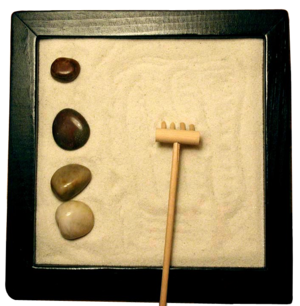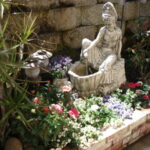A Zen Garden, also known as a dry or Japanese garden is a garden made primarily of sand and rock which is cultivated to appear as a landscape or ocean. The sand within a Zen garden is meant to be regularly raked into new soothing and thought provoking patterns. Zen gardens can consist of solely sand or pebbles and larger stones, but many also contain moss or trees. Flowering plants are rare to true Zen gardens.
The Zen garden is an ancient Japanese art originally called “Karesansui” which translates quite literally to “dry-mountain-water”. The sand or small pebbles in a dry garden are meant to represent water, and the larger stones represent mountains and hills. Many also feel objects within a Zen garden can have special meaning to the person tending it as metaphors for things within their lives or the world. When introduced to the western world these dry rock gardens took on the name Zen garden in reference to the Buddhist school of Zen which encourages calm, enlightenment and introspection.
Whether for meditative or aesthetic reasons a Zen garden can be a wonderful and soothing addition to any home or office. This simple guide will provide the necessary information to design your own Zen garden as well as lead you step by step though how to make a Zen garden.
Planning a Zen Garden:
Step one in any garden project should always be planning. This is vital to ensuring an organized and smooth creation. Here are a few questions you should answer when planning your Zen Garden.
What size do I want my garden and where do I want to put it?
A Zen garden can be as large or as small as you desire or have space to create from a desk top box to a full backyard creation. Decide how large you want your garden and where is an important first decision.
How much work do I want to put into this garden?
Almost a subcategory of size, how much work you want to put into a Zen garden is another important consideration. Naturally the larger the garden the more maintenance will be required and work to set up initially. A Zen garden does require some upkeep as weeds, animals using them as liter boxes and other debris can destroy the Zen of a rock garden.
How much money do I have to spend on supplies?
The advantage of a Zen garden as the majority of elements to make it can be found in nature. They can be a fairly in expensive addition to any home. There are a few expenses that can cut maintenance such as a weed guard under the sand or pebbles. Depending on size purchasing such items could become expensive. Or if you chose to purchase sand or pebbles rather than just getting them from the beach that would cost as well. When factoring budget, consider where you will obtain your elements and what elements you want. Step two of this how to guide will provide more information on what sort of elements you may want to think about.
Elements of a Zen Garden:
The most important elements in a Zen garden are sand and rocks. Without these two things the garden is not a Japanese rock garden at all.
Sand:
White is the most commonly used color of sand for dry gardens as it shows the raked patterns best. White is also considered a color or purity and calm. Any sand can be used in a Zen garden however even if you just picked it up at the beach. Grey, Beige and Black sand are also wonderful choices. Some feel only crushed granite sand should be used in Zen gardens, but again this is not entirely necessary.
In larger gardens small pebbles are often used to cut down on sand usage. You can even both uses making areas of pebbles and areas of sand to show a difference in the “rock water” texture.
Rocks:
Usually a Zen garden contains one or a few very large stones to represent mountains and then smaller stones to reflect hills. Take time in selecting your stones. Go for stones with colors or textures that interest you. The act of choosing stones for a dry rock garden can be soothing all in itself. Simply take a nice walk through the woods or along the beach and select items that jump out at you.
Plants:
Though flowering plants are usually not present in Zen gardens moss, grass or trees are.
Moss is often either grown on rocks or places in patches to represent islands in the sea of rock. You can easily take local moss and apply it to your rocks by obtaining a small chunk and blending it in a blender with buttermilk and water. Once blended simply paint the mixture on rocks and moss will grow. Chunks can simply be transplanted to the desired location to make islands. Other leafy or vine plants and/or ground cover may also be attached to rocks if desired.
Grass is often used much like the island method of using moss and may be in large or small patches depending on the size of the Zen garden.
Evergreen trees are often used in dry rock gardens to cut down on maintenance though some other species are sometimes used. Some trees that compliment a Zen garden well include:
*Pine
*Holly
*Hemlock
*Mountain Laurel
*Maples
*Cherry and/or Apple
Trees and shrubs should be used sparingly.
Other Elements:
A Zen garden should be a representation of the person tending its mind. You can include anything you want from logs to pottery, fountains (though the garden should be primarily dry they can be contrasted with a near by water garden very well.) to statues. The main idea however is to make the sand and rocks the focal point, so keep that in mind.
The final step is to actually create your Japanese rock garden and maintain it thereafter.
To create a Zen garden :
First you need to obtain or create a mold to keep the sand or rocks in place. For a smaller Zen garden you could use just about any container. Some people have even been known to create small desktop gardens in Altoids tins. For a larger garden you’ll need to create the mold by outlining your desired area in boards.
Next in the case of an outdoor garden you’ll want to lay some kind of weed determent such as black plastic. Then simply fill the mold with your desired elements.
To maintain a Zen Garden :
Zen gardens are not set in stone. The elements within the garden can be regularly re-arranged and changed. The sand is often and should be raked into new designs at your desire. Other than optional altercations a Zen garden should be kept free of weeds and debris to represent the clarity of the mind. Avoid letting your mind or your garden become untidy.
You may also enjoy:
Recyclables in the Garden
How to Build a Trellis
How to Make Trash Bag Planters





